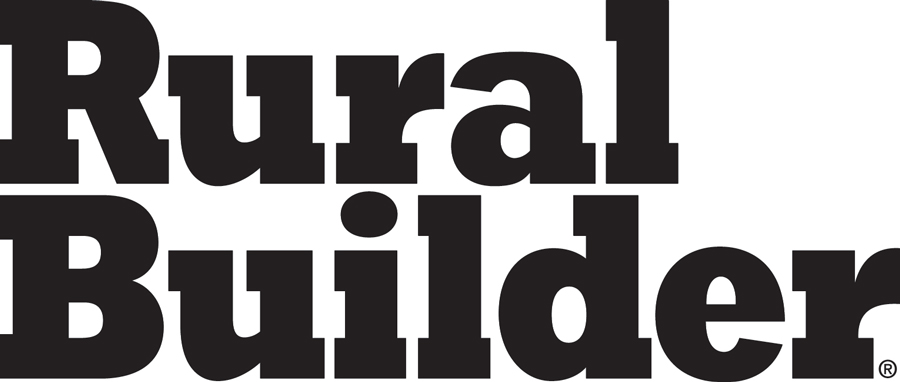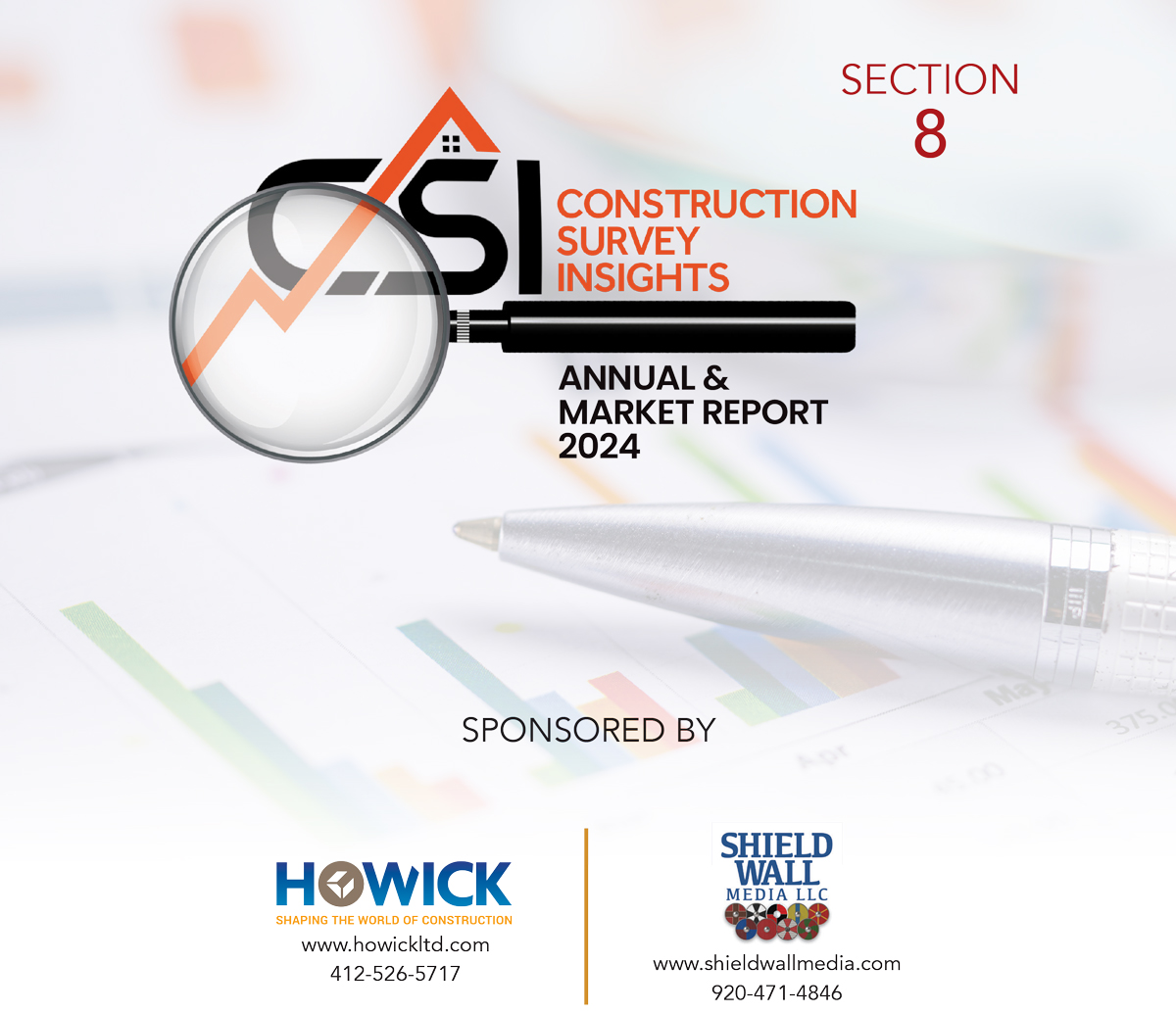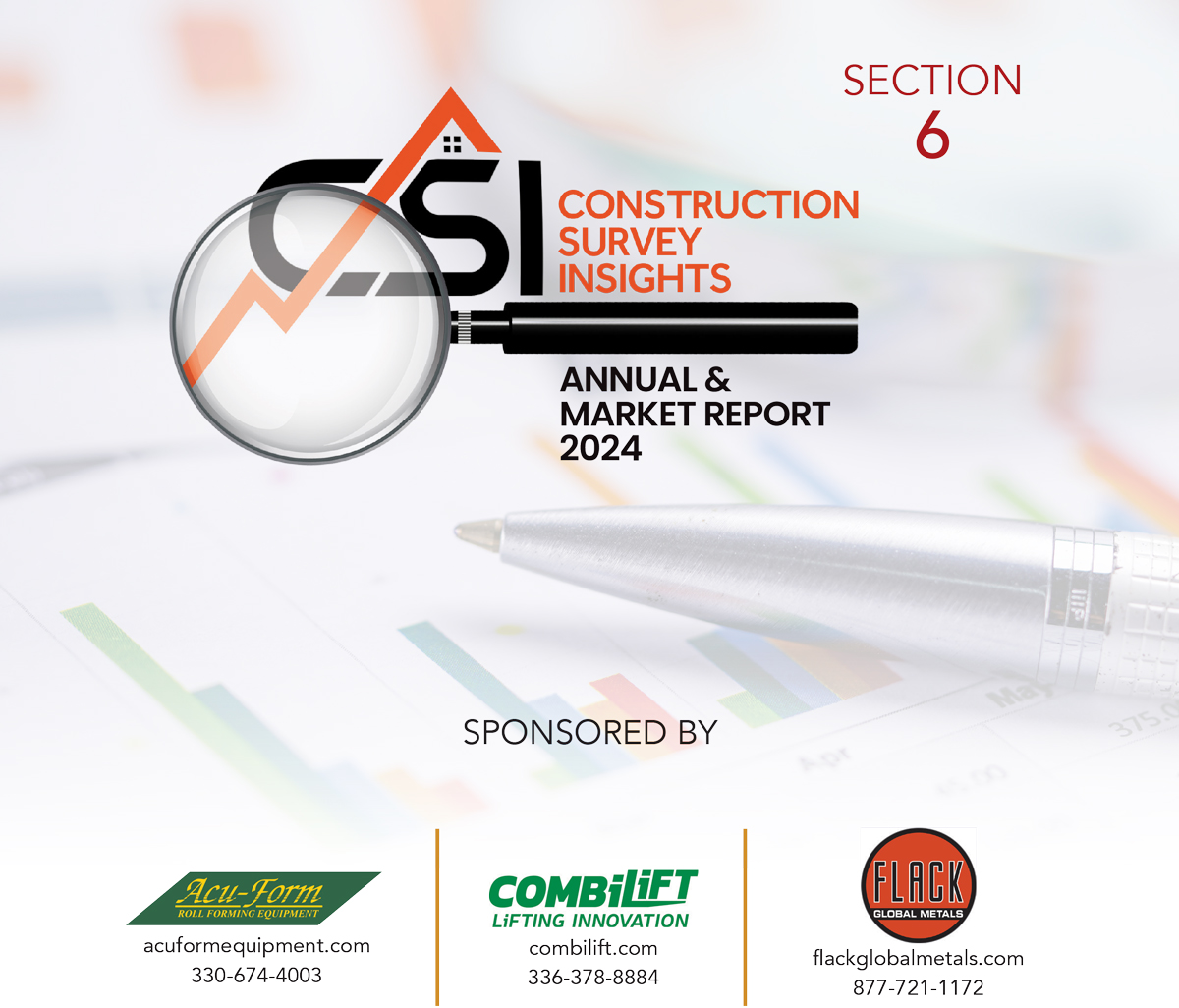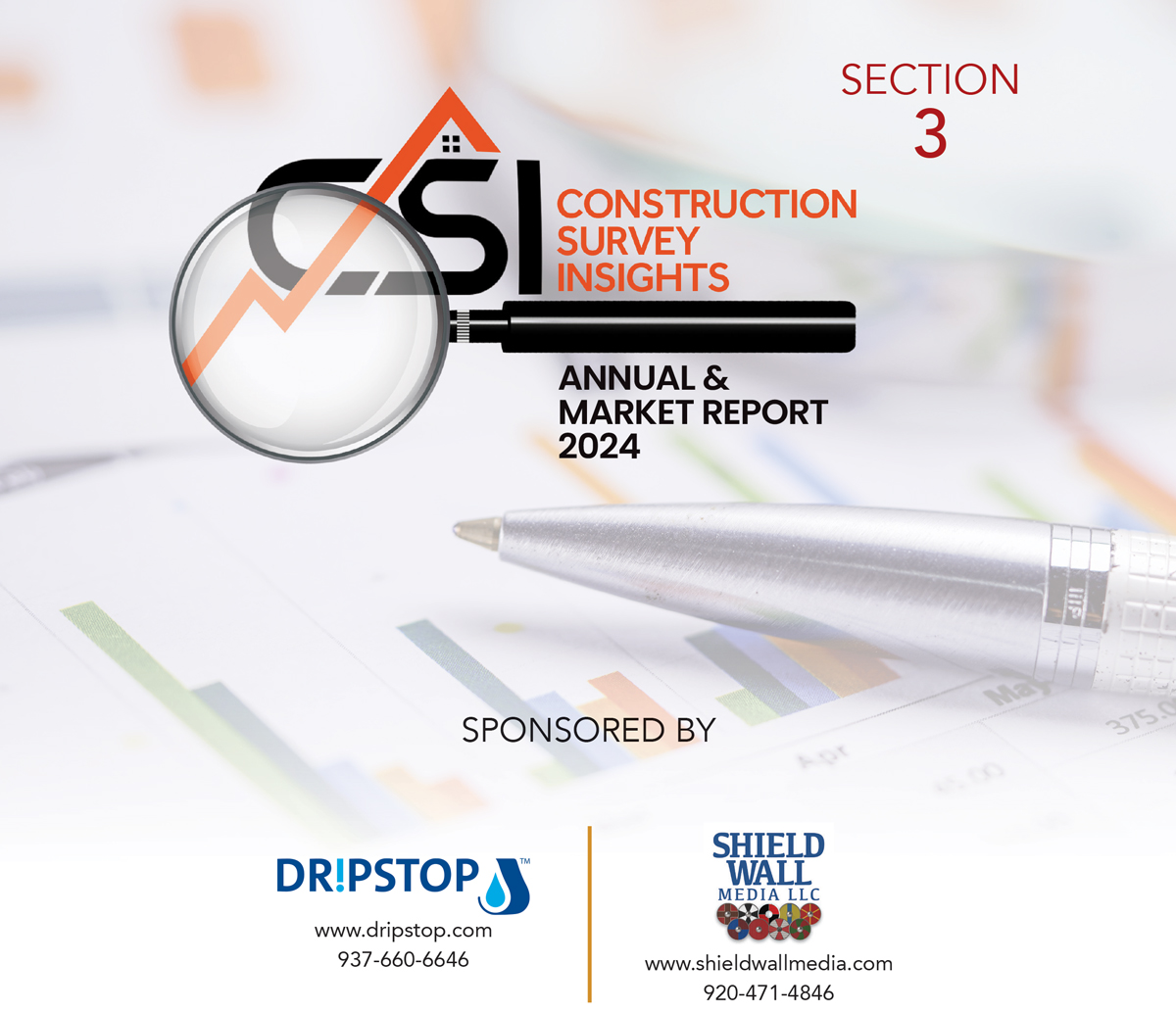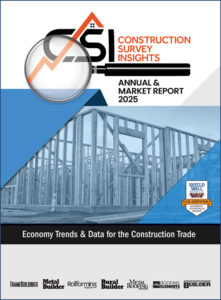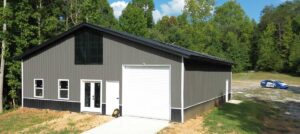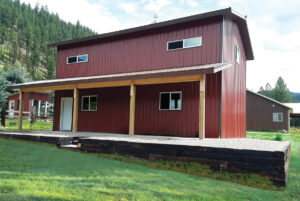Metal Roofing Data
By Paul Deffenbaugh, Contributing Editor
Who are metal roofers? It’s hard to say. They are general roofing contractors who offer metal roofing services. They are metal roof specialists in commercial and industrial construction. They are residential roofers who have metal roofing as a service. They may be suppliers or distributors who offer installation services. They are metal roofers who specialize in residential retrofits, which is becoming a much larger industry. Dodge Data and Analytics reports that demand for residential metal roof retrofits reached 18 percent of market share in 2022, which is a 6 percent leap in three years.

There are difficulties the industry faces, though, and Jim Bush, vice president of sales and marketing for ATAS International, Allentown, Pa., cites the competition from other building products in talking about the sustainability of their products. “Competitive building materials are pushing sustainable attributes of their products in a much better way than those of us in the metal arena,” he says. “As an industry we must do a better job communicating a universal message on the green and environmental benefits of metal building products.”

Characteristics of the Metal Roofing Industry
Of the companies who identify their primary business as metal roofing, half work in the residential construction market, evenly divided between single-family and multifamily. Slightly more (27.8%) serve the agricultural, and the remainder work in commercial (13.9%) and industrial market segments (8.3%). T1

It’s not shown on this chart, but the data from the Shield Wall Media Construction Survey Insights show that of respondents who identified metal roofing as their primary building type, 60% are contractors, 18% are distributors, and 10% manufacturers.
In keeping with the nature of the metal roofing market, far more companies actually are engaged in metal roofing than have that as their primary business. Among that group, more than half (53.7%) serve the single-family market. The next most common market segments served by companies engaged in metal roofing were multifamily (43.5%) and commercial (42.6%). About a third of companies worked in agriculture and a quarter worked in the industrial market segment.
About 80% of metal roof shipments are for residential installation, according to the Metal Construction Association, with standing seam metal roofing representing about 65% of that total.
For our purposes, we were interested in companies that were engaged in metal roofing, and of that group 28.2% were based in the East and a similar percentage in the South. A quarter (24.6%) of these companies were based in the Midwest and only 10% came from the West. We did have a small number of companies reporting out of Canada (4.6%) and working nationally (4.6%). There were not enough survey takers from those areas to include them in much of the reporting because the data was too unsteady. T2

Most of the survey takers who were engaged in metal roofing (47.7) described their role as builder or contactor. Another quarter (24.8%) were designers. That may have been independent architectural firms or designers who were part of a design-build contracting company. Smaller numbers came from the distributor role (16.6%) but as mentioned previously, some companies might do installation as well as material distribution. The remainder (11.9%) were manufacturers. T3
The Metal Roofing Alliance reports that metal roofing represents about 18% of all residential roofing retrofits, and there are companies very specifically working in that segment. They tend to be single-line remodeling companies who operate similarly to traditional roofing and siding remodeling companies, but specialize in metal roofing. T4
Roughly a third of the survey takers do about half new construction and half remodeling work. But the trend among companies engaged in metal roofing is toward new construction, with 36.6% doing more than 60% new work and 30.4% doing less than 40% new work.

Among our respondents, about 44% have an average job size less than $25,000 which would include the typical metal roof retrofit on a residence. A quarter have a job size between $25,000 and $100,00 and 30.6% have an average job size of more than $100,000. That would entail large commercial projects and retrofit roofs for institutions, such as public schools. T5
A job size of less than $5,000 is likely a repair project. Although, since manufacturers and distributors are included in the make-up of companies engaged in metal roofing, that number could include simply the cost of the materials shipped.
On average, 30.1% of companies engaged in metal roofing had gross sales in 2023 of less than $2 million. Companies from the South represented the most significant portion of that, with 41.9% of those companies reporting sales below $2 million. T6
Companies based in the East tend to be much larger with 19.4% of those reporting 2023 gross sales of greater than $50 million. As we have seen in other areas of this report, the data from these companies is more volatile than other regions and may be driving up the average number of companies reporting sales greater than $50 million.

The region where you are least likely to find small companies engaged in metal roofing is the West (18.2%), and those companies tend to be clustered between $2 and $10 million in 2023 gross sales.
Projected Industry Growth
Companies engaged in metal roofing are generally feeling good about the prospects for the construction industry in 2024. Just over 40% expect conditions to improve compared to 2023 and 34.8% anticipate things staying the same. T7
Richard King is product manager for Steelscape, Kalama, Wash. He has a relatively positive view of industry growth, but expresses reservations. “I think on the whole it is ok and better than expected,” he says. “But it is very varied by sub sector – commercial, residential, public – and building type sub sectors, such as warehouses, schools, etc. Some sectors are strong whereas others are weak due to interest rates. A lot of commercial schedules are moving out, which is contributing to industry volatility and difficulty in projecting demand.”
Bush says, “I have been anticipating a minor downturn due to construction starts being off in the range of 25% in the 2020 time frame. The overall impact has been spread out over a broad time frame and really has not affected the daily business activity in the construction markets. I still anticipate a slight softening in 2025 due to the high interest rates over the last year or so. However, I do not see any major changes in the health of the economy that will affect the use of metal in construction.”
There are other, larger forces affecting the construction industry and the U.S. economy as a whole. Societal changes are having an impact at all levels of our industry. King points to one specific thing that everyone in the industry recognizes. “Expectations are shifting in terms of how quickly we must respond to change, communicate, and provide solutions,” he says. “So we must continue to improve our agility through technology and people investments.”
When asked about how individual market segments will do in 2024 compared to 2023, companies engaged in metal roofing were generally positive. About 50% of respondents thought each of those segments would improve, although they were slightly less enthusiastic about the agricultural market’s growth with 45.1% suggesting it would improve. T8
But 46% thought the agricultural market would hold the same and only 9% predicted a decline. So, overall, the agriculture market reveals stronger expectations than the other market segments.

Survey takers thought the other three markets – residential, commercial, and industrial – all held about the same prospects with generally a third thinking they would hold steady and 15% expecting them to decline in 2024.
The good news among companies engaged in metal roofing is that 2023 was, on average, a better year than 2022. A total of 64.3% of respondents say their business improved year over year with 90% of the companies in the West showing an increase. Of those companies, 63.6% saw an increase less than 25%. T9

Companies in the East (our most volatile region) say their businesses increased more than 25% in 2023 with 32.3% of them reporting a significant jump. Very few companies engaged in metal roofing in the Midwest (3.7%) report a large leap in gross sales in 2023. They were far more likely (40.7%) to say their gross sales had remained the same during this period.
No respondents from the West report a decline while 19.4% in the East say their revenues declined but not significantly or less than 25%. The region where the most survey takers who are engaged in metal roofing say they had significant declines was the Midwest with 7.4% of them reporting greater than 25% drops in 2023 over 2022.
Looking to projected gross sales for the 2024 time frame, about the same number of respondents engaged in metal roofing on average say their gross sales will increase in 2024 as saw increases in 2023. This year, 61.3% expect an increase while 64.3% reported an increase last year. T10
Companies based in the Midwest were generally both more positive and more negative about growth this year with a third expecting a slight increase while 11.1% anticipating gross sales jumping more than 25%. A total of 40% of respondents report an increase last year, and this year 44.4% expect an increase. The real change was the number of companies who reported flat sales in 2023 (40%) shrank as now 33.3% anticipate gross sales remaining the same in 2024. Those in the Midwest projecting a decline in 2024 totaled 22.2%. Only 18.5% of respondents from the Midwest say they say declines in 2023.

While companies in the West who are engaged in metal roofing report no declines in gross sales in 2023 compared to 2022, 18.2% anticipate a slight decline in 2024.
Profit can be a tricky thing to manage for small companies. On average, 30.1% of the companies engaged in metal roofing had gross sales below $2 million in 2023. At the same time 69.3% of companies engaged in metal roofing had an average job size of less than $100,000, and 25.2% had job sizes between $25,000 and $100,000. Small companies running large jobs can create significant shifts in profitability if one job goes bad or another is a home run. T11
Comparing 2023 to 2022, 29.9% of companies engaged in metal roofing saw profitability hold and 10.4% saw it decline with 2.7% seeing a decline of greater than 25%. Considering 14.5% saw declines in gross sales during that same period, the profitability picture for these companies remained pretty strong. Yes, there will be lean years, but if companies can manage resources to hold profit and mitigate risk, they have long-term survivability. By the number in our survey, that seems to be what companies engaged in metal roofing did in 2023. T9, T11 & T13
Breaking it out by region, companies in the West were more likely to see profit increases (72.7%) than other regions and none of them report a profit decline in 2023. The South and Midwest survey takers were more aligned with each other with relatively equivalent percentages showing profits up less than 25%, the same, or down less than 25%. T11
When projecting 2024 profitability increases over 2023 profitability increases, the respondents from the West came back down to earth a bit. 63.6% of companies engaged in metal roofing from this region reported their profits up less than 25% in 2023 and only 45.5% anticipate a similar increase in 2024. But the initial blush falls apart with companies in this region when you look at respondents who expect a greater than 25% increase in profitability. Of companies from the West, 36.4% project significant profit increases in 2024 while only 9.1% of them showed such a year-over-year increase in 2023. None of these companies expect profits to hold steady. T11 & T12

On average, though, 60.7% of companies engaged in metal roofing expect to see a profit increase in 2024, and 20.1% project a decline. Whereas South and Midwest companies were very similar in reporting on 2023 profits compared to 2022, they vary considerably in their expectations for 2024. Of companies in the South, 56.7% expect an increase in profitability and 23.3% project a decline, leaving only 20% who predict profitability will remain steady. Of those from the Midwest, though 40.7% project profits to remain the same in 2024and only 25.9% anticipate a decline. T12
Company Size and Growth Projections
In 2023, companies engaged in metal roofing who served the multifamily market were more likely to report an increase in gross sales over 2022 than those serving other market segments. 69.6% survey takers in the multifamily market reported an increase in sales with 28.3% of those saying the increase was greater than 25%. T13
The other side of the residential market, single-family construction, also had respondents who said sales jumped in 2023 with 65.6% of the total coming in with higher sales and 25.9% showing gains of greater than 25%.
The agricultural market, according to companies engaged in metal roofing, was least likely to see an increase in sales in 2023 compared to 2022. Half of the companies serving that market report an increase and they were the fewest (15.8%) of any market segment to show a significant increase of greater than 25%.
They were also the most likely to report gross sales as the same (29%) or down (21.1%), although 20% of companies in the commercial market saw gross sales decline in 2023.
When you look at the totals of companies engaged in metal roofing across market segment, there isn’t a lot of difference from the percentage who reported increases in 2023 and those who project increases in 2024. Nearly the same percentages hold for multifamily(69.6% in 2024, 69.6% in 2023) and single family (65.5% in 2023, 63.8% projected in 2024). The agricultural market is projected to rise about 10 percentage points from 50% to 60.5% and commercial drops about 4 points from 60% to 55.6%. T13, T14

There are shifts in the optimism about growth with companies being much more diffident about anticipating significant growth. Among companies engaged in metal roofing, the average who report more than 25% growth in 2023 over 2022 was 21.9%, and 39.3% report slight growth. Those numbers shift when looking at projections for 2024. Only 16.9% of companies, on average across market segment, expect significant growth while 45.5% project slight growth. About the same percentage anticipate either the same gross sales or declining gross sales in 2024 that they reported in 2023. T13 & T14
About the same percentage of companies engaged in metal roofing believed that the decline of gross sales would be similar to what they experienced the previous year (15.9% in 2023 and 16.4% projected in 2024). But there was a shift in attitudes. Respondents were less likely to think there would be significant declines across market segments served. On average, only 1% of companies expect significant declines in 2024 compared to 3.1% who reported significant declines in 2023.
Across the board, companies engaged in metal roofing were able to hold profitability in spite of changes in gross sales across market segments. 15.9% of respondents reported 2023 sales declines but only 10.4% reported a profitability decline. For all the respondents who reported their sales were roughly the same as 2022 across these market segments (22.8%) there were far more (33.9%) who reported their profitability was the same.T13, & T15

The market segment where companies engaged in metal roofing saw the biggest profit increases in 2023 was multfamily with 65.3% of survey takers who say their profits increased year over year. Of the other segments, they all averaged just slightly more than 50%. Those in the agricultural market (13.2%) were less likely to report a significant increase than the ones working in other market segments. T15
Of those reporting declines in profitability, companies serving the multifamily (6.5%) and agricultural (7.9%) were the least likely to show a decline, with none of the multifamily respondents reporting a decline of greater than 25% in this segment.
In 2023, 17.8% of companies engaged in metal roofing reported an increase in profitability greater than 25% over the previous year. In 2024, 23.3% of companies projected a profit increase of greater than 25%. Clearly, companies were much more optimistic about their prospects in 2024 compared to their experiences in 2023. T15 & T16
About the same percentage reported a significant decline in profitability in 2023 (3.1%) as they projected in 2024 (2.6%), but the total of companies reporting any decline in 2023 (10.4%) was similar to the number who project a decline in 2024 (16.4%).T15 & T16
For companies engaged in metal roofing, the prospects of a 2024 decline in profitability were least among multifamily companies (10.6%) and greatest among agricultural (23.7%). Three segments – single-family, agricultural, and commercial — all projected profits to increase at about the same percentage of likelihood (about 57%). T16

Companies engaged in metal roofing who work in the multifamily segment market were most likely (70.2%) to project increasing profits in 2023.
Future Opportunities and Challenges
In keeping with the theme throughout this report, respondents working in the multifamily sector were the most optimistic, and that includes companies engaged in metal roofing. More than half (52.2%) of these companies have expansion plans for 2024 and another 28.3% expect to expand in the future. Only 19.6% have no expansion plans. T17

Firms working in the commercial segment are least likely to have plans to expand. Not quite half (44.4%) of companies engaged in metal roofing in the commercial sector have no plans to expand although about a third (37.8%) do have immediate plans.
Companies serving the agricultural segment were evenly divided with about a third each having immediate plans to expand (31.6%), future plans (31.6%), and no expansion plans (36.8%). T18

For companies in the roofing market and for those in metal roofing, the ability to add new products or building types is relatively easy and a strong business practice. If you’re doing metal roofing, why not add modified bitumen or built-up membrane? The same can be said about adding metal roofing to the existing mix of products and services. Employees can be trained easily to work on different roof types and many distributors already carry a full complement of materials, so there would be little need to find new
suppliers.

It’s no surprise then, that the companies engaged in metal roofing report they are most likely to add new products or building types in 2024. This goes across all segments, with respondents in single-family, multifamily, agricultural, and commercial all saying they are most likely to add new products than add any other resources. T18
The next areas of expansion companies are considering are both support and field employees, although companies engaged in metal roofing serving the single-family market are less likely to look at support employees than field employees or even jobsite equipment. Survey takers in the agricultural segment are least likely to be looking for field employees and multifamily companies are least likely to be planning to add jobsite equipment.
Many expansion plans require capital expenditures, including real estate, metal forming equipment, manufacturing equipment, material handling equipment and trucks. About 12.6% of companies engaged in metal roofing have no plans to add resources.
Among companies engaged in metal roofing, finding employees (60% on average) ranked as the highest challenge, and companies serving the residential market segments reported finding employees is the biggest challenge or tied with cost of materials for the biggest challenge, while commercial companies believe dealing with the rising cost of materials is a bigger challenge. Agricultural companies pointed to the rising cost of employee-related expenses as their biggest challenge. T19
Jim Bush of ATAS International says, “Finding qualified employees across all levels of the organization is still difficult, although it appears to be getting somewhat better.”
Richard King of Steelscape agrees. “I think the health [of the industry] is good, although we face future issues in terms of our ability to attract and retain talent, and to transfer knowledge between the generations as one leaves and the other takes over.”
There are other challenges for companies engaged in metal roofing; all make controlling cost of construction more difficult and can push building owners to slow or cancel plans. It’s a bit surprising to see supply chain issues still getting as much attention as they are in both material availability and general supply chain issues several years after the pandemic disrupted the global supply chain.
Check out the whole Construction Survey Annual & Market Data 2024!
